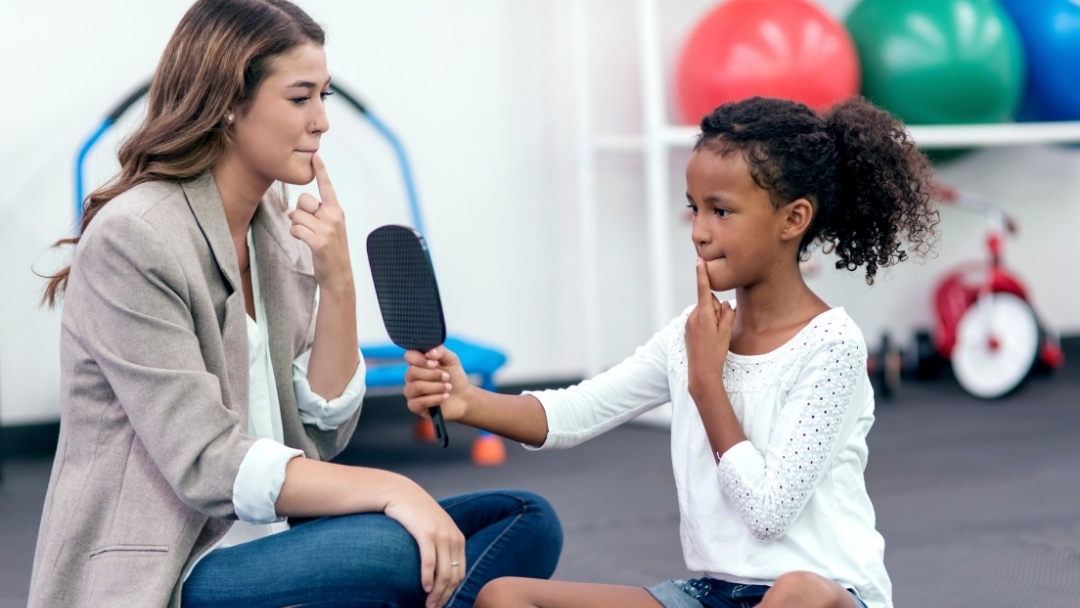What Are Speech and Language?
Speech and language issues are common in children with neurodevelopmental disorders such as autism, ADHD, Sensory Processing Disorder and learning disabilities.
Speech
Speech is the mechanical means of the oral motor mechanism to create sounds. Intelligible speech requires sufficient muscle tone for the lips, jaw, tongue and cheeks to work together as a team to produce functional verbal communication. Sometimes people use the word “articulation” for speech.
Language
Language, on the other hand, is how the brain processes the information that it hears. Language can be receptive (understanding) or expressive (communicating). Receptive language allows a person to give meaning to what is heard. It is comprehension. It begins to develop in the first year of life in a typical child.
Expressive language is the ability to be able to share thoughts, ideas and feelings. It can be verbal (with sound) or non-verbal (with gestures, signing or use of technology). It generally does not begin to emerge until the second year of life.
What Your Doctor May Tell You About Speech and Language
Lack of the emergence of speech and language is one of the first areas of concern for parents. Your pediatrician may tell you not to be so concerned, as all kids are different, or that boys talk later. He or she may also recommend a hearing test to rule out auditory problems.
If the child is over two, your doctor will usually suggest an evaluation from a speech-language pathologist, or at a communication disorders clinic, or refer you to your local early intervention services.
Another Way to Think About Speech and Language
Early intervention is imperative, but please know that a nonspeaking child very often has very good receptive language; they may understand everything that is said to them and around them but likely lack the fine-motor ability to speak. Nonspeakers can learn to communicate with assistive technology with their gross-motor skills using letterboards.
If you suspect a speech and language delay, the earlier you recognize that your child is not meeting developmental milestones and implement intervention strategies, the better the chances of more effective outcomes for your child.
The most important goal is to discover why a child lacks understanding of what is said or is not talking. Look at all possibilities. The answer is rarely one thing; it is usually a combination of some or all of the following:
- Biomedical issues
- Auditory issues
- Visual processing issues
- Primitive reflex integration issues
- Vestibular issues
- Structural issues
- Oral-motor issues
- Neurological damage, including a stroke
While a hearing deficit is an obvious reason for speech and language delays, very often, some underlying biomedical reasons that are not so obvious are at play.
Biomedical Issues
Researchers have recently made great gains in the understanding of biomedical causes of speech and language issue, such as:
- Defects in detoxification pathways
- Nutritional deficiencies in the brain, especially folate (B9) and methyl B12
- Malabsorption of fatty acids (fats)
- Choline deficiency
- Vitamin E deficiency
- N-acetyl-cysteine deficiency
- Glutathione deficiency
- Fatty acid deficiency
Once underlying biological issues are addressed, speech and language may improve gradually, or could even emerge spontaneously. Other senses besides hearing can also impact upon speech and language.
Vestibular Issues
The body’s vestibular system, which creates balance and equilibrium, plays a significant role. Children with vestibular dysfunction may have auditory and language processing problems.
Vision Issues
Vision refers to the brain’s ability to process the information coming in through the eyes; acuity refers to the eyes’ ability to see well at a certain distance. Visual processing uses up most of the brain’s bandwidth, and having impaired vision can cause undue strain on other functions of the brain, including speech and language.
Therefore, once a child’s visual processing issues are corrected with vision therapy, his or her language may improve because the brain now has more capacity.
Speech and Language Healing Checklist
Have Your Child Evaluated for a Tongue Tie
Many children with a neurodevelopmental disorder often have tongue ties, which means that their tongues cannot move freely around their mouths, leading to problems with swallowing and verbalizing. A tongue tie is difficult to evaluate, and you may get different answers from different practitioners.
Find a practitioner who is adept at looking for tongue ties; one who works in conjunction with myofascial therapists and oral motor therapists is best.
Consider Hyperbaric Oxygen Therapy (HBOT)
If your child had a difficult birth resulting in insufficient oxygen to the brain or a negative reaction to routine childhood medical interventions, consider Hyperbaric Oxygen Therapy, which can increase oxygen levels in the brain. Because this type of therapy is also helpful for stroke victims, you may want to consider that your child may have had a stroke.
Consider a One-on-One Educational Program in the Home and at School
If you are home schooling, the Vince Carbone Clinic and CARD (Center for Autism and Related Disorders) are good resources for you to check into.
Still Looking for Answers?
Visit the Epidemic Answers Practitioner Directory to find a practitioner near you.
Join us inside our online membership community for parents, Healing Together, where you’ll find even more healing resources, expert guidance, and a community to support you every step of your child’s healing journey.
Sources & References
Borre, Y.E., et al. Microbiota and neurodevelopmental windows: implications for brain disorders. Trends Mol Med. 2014 Sep;20(9):509-18.
Frye, R.E., et al. Folinic acid improves verbal communication in children with autism and language impairment: a randomized double-blind placebo-controlled trial. Mol Psychiatry. 2018 Feb; 23(2): 247–256.
Gabis, L.V., et al. Improvement of Language in Children with Autism with Combined Donepezil and Choline Treatment. J Mol Neurosci. 2019 Oct;69(2):224-234.
Jadavji, N.M., et al. B-vitamin and choline supplementation increases neuroplasticity and recovery after stroke. Neurobiol Dis. 2017 Jul;103:89-100.
Morris, C.R., et al. Syndrome of allergy, apraxia, and malabsorption: characterization of a neurodevelopmental phenotype that responds to omega 3 and vitamin E supplementation. Alternative Therapies in Health and Medicine. Jul-Aug 2009;15(4):34-43.
Warner, B.B. The contribution of the gut microbiome to neurodevelopment and neuropsychiatric disorders. Pediatr Res. 2019 Jan;85(2):216-224.
Zaigham, M., et al. Prelabour caesarean section and neurodevelopmental outcome at 4 and 12 months of age: an observational study. BMC Pregnancy and Childbirth. 2020 (20)564.
Resources
Articles
Bronston, Berri. Devoted dad is partner in autistic graduate’s success. 22 May 2018, Tulane News.
Kedar, Ido. I Was Born Unable to Speak, and a Disputed Treatment Saved Me. 23 Sep 2018, Wall Street Journal.
Books
Kedar, Ido. Ido in Autismland: Climbing Out of Autism’s Silent Prison. 2012, Sharon Kedar.
Mukhopadhyay, Soma. Understanding Autism through Rapid Prompting Method. 2008, Outskirts Press.
Peña, Edlyn Vallejo. Leaders Around Me: Autobiographies of Autistics who Type, Point, and Spell to Communicate. 2019, independently published.
Websites
California Lutheran University Autism and Communication Center
Helping Autism through Learning and Outreach (Soma RPM)




